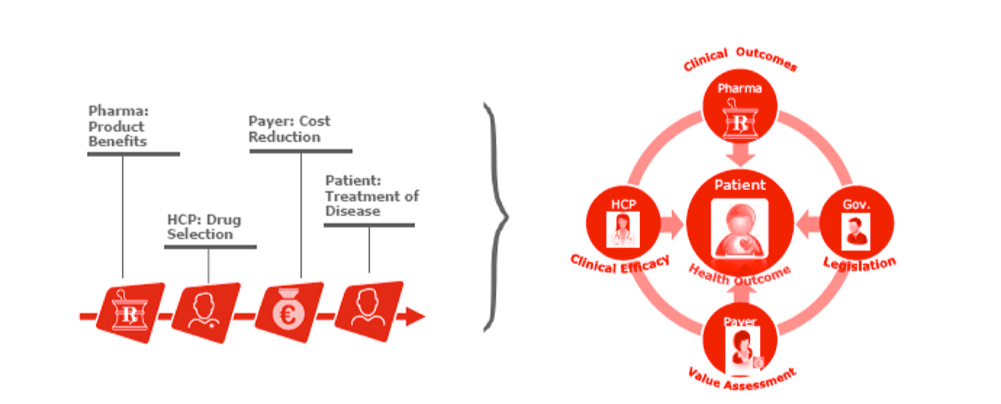Nowadays, customers across the board are becoming more informed and more empowered. In today’s market, organisations can no longer rely solely on delivering a great product or service to drive sales. Instead, consumers are choosing to buy based on their overall experience interacting with a brand or company, meaning that now, it is all about the total customer experience, from the very first encounter, all the way until the last and everything in between. This shift in buying behaviour presents significant challenges and opportunities for companies across all industries, including the Health Care Sector. In order to both survive and thrive in this area, life science companies must engage the right customers, with the right messages, through the right channels, at the right time, while also respecting the many rules and regulations.
In the past, pharma sales were dependent on the salesperson convincing the doctors to prescribe their drug. Today multiple stakeholders are now involved, meaning that pharma sales employees need to engage and satisfy each player if they want to make a deal (see the figure below). With these stakeholders located across boundaries, and with diverse and often contradicting needs and expectations, pharma companies must have a comprehensive customer experience strategy in order to evolve and grow. The value proposition, messaging and engagement strategies should change depending on whether the customer is a payer, patient or physician, as well as according to the geographical location of each of these different customers. The general public’s increasing lack of trust in the healthcare sector is another challenge for the pharma industry, that makes interacting with customers even more complicated.

Regulator
‘‘I want to accelerate innovation and license products and diagnostics that demonstratereal outcomes.’’
Patient
‘‘I should be informed of decisions relating to my health and able to manage my condition to fit my lifestyle.’’
Payor
‘‘I must contain healthcare costs without compromising patient outcomes.’’
Policymaker
‘‘My policies need to encourage uptake of innovation and meet my stakeholders’ needs.’’
Provider
‘‘I need to adhere to evidence-based medicine to optimize my performance and deliver excellent patient outcomes.’’
Therefore, a complete customer experience strategy for healthcare practitioners, payers, and patients is needed for organisations to understand their customers’ expectations and needs, and align their interactions accordingly.
Engaging Healthcare Practitioners (HCPs)
Engaging HCPs through well-designated patient support solutions is essential. However, according to recent surveys, HCPs also consider remote engagement through virtual channels as one of the preferred communication channels. A growing demand for transparency, increasing consumer engagement and new patterns of consumer behaviour (largely due to access to mobile networks and data) are challenging medtech companies to transform the way in which they design, market and deliver their products and services. HCPs have started to shift towards virtual and augmented reality solutions that provide a tangible and powerful experience, not possible with brochures, speeches, websites or even videos.
Engaging Payers
Payer organisations worldwide are focused on bridging the gap between funding and medical costs, often in the context of a changing regulatory environment. Effective solutions need to be tailored to local healthcare systems and payor organisations must find the most effective way to influence the evolution of their healthcare systems. Leaders of hospitals, academic medical centers and pharmacies need to devise strategies to not only deliver value for patients, but to also generate financial results and be competitive in their local markets. Knowing who the decision makers are amongst payer organisations can really improve the relationship with life science companies, subsequently helping to transform the customer journey. Communication via multiple channels, together with additional research and analysis is needed to create a detailed road map for each payer journey. Powered with this data, companies will then be able to map the most significant variations of each payer’s experience.
It is also imperative that life science organisations work on restoring the trust between health care services and the public, since without it their data and solutions will get little traction with payers. At GSK, this has meant working across the organisation to review data and incorporating the payer voice earlier in the R&D process, including payer advisory boards that provide feedback before clinical trial candidates reach phase II development.
Engaging Patients
Patients have quickly become the strongest influencers in the healthcare ecosystem. Having acquired unparalleled access to health information, they are now increasingly empowered to make their own decisions when it comes to personal health and treatment. As a result, patient centricity has become a key strategic focus for the pharma industry today, with some even dubbing it the ‘holy grail’ of modern pharma.
Subsequently, increasing numbers of companies are positioning and promoting themselves as “patient centric organisations”. UCB, for example, uses the tagline: “Inspired by patients, driven by science’’, while AstraZeneca, state: “Science and patients…the heart of everything we do,” and Sanofi claim to be: “A global integrated healthcare leader focused on patients’ needs.” Nevertheless, the aim of patient centricity is still sometimes overlooked and many cultural barriers need to be tackled before it can be fully embraced.
According to IMS health, patient centricity initiatives face four major barriers:
- 25% showed inability to uncover real patient insights
- 65% have fear of violating privacy and other regulations
- 50% lack patient centric organisational structure and processes
- 71% lack clear measures of success and ROI
AstraZeneca and BMJ Innovations recently published the first collaborative definition of patient centricity for the pharmaceutical industry. The definition was co-developed with both patients and caregivers, using research led by AstraZeneca, as well as patient community advocates to ensure a deep understanding of patient needs and values, with a consistent reference point to sustain meaningful and mutually beneficial engagement with patients.
The research published in BMJ defines patient centricity as: “Putting the patient first in an open and sustained engagement of the patient to respectfully and compassionately achieve the best experience and outcome for that person and their family.” This definition encompassed five clear points of importance to patients who were identified and validated through the research: (1) Inclusiveness; (2) Sharing goals that are patient and family centered; (3) Empowering patients to take control of their own health; (4) Working in a way that shows respect, compassion and openness; and (5) Working in partnership.
Final Thoughts
The healthcare industry is more transparent than ever before, and keeping in tune with the change, pharma companies are evolving to become service providers rather than solely drug manufacturers. Through this transition, pharma companies have recognised that all stakeholders – patients, healthcare providers, payers, and health IT companies – must collaborate to succeed in providing value-based care.
Working with all stakeholders allows both life science companies and clinicians to access the knowledge they need to make health care better for everyone. Results so far show that patient engagement initiatives have already led to improvements in adherence to medicine, as well as the overall quality of life associated with chronic diseases such as heart failure, ulcerative colitis, and asthma.





